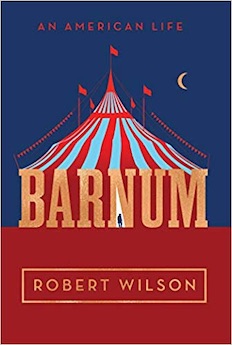By Louis J. Kern
“Man is an animal that diddles,” wrote Edgar Allan Poe, “and there is no animal that diddles but man . . . to diddle is his destiny . . . [but] a diddle would be no diddle without a grin” (“Diddling Considered as One of the Exact Sciences,” 1835). P.T. Barnum recognized his similitude in his 1841 pseudonymous seriatim novella, The Adventures of an Adventurer, Being Some Passages in the Life of Barnaby Diddledum (1841), whose picaresque hero laughs at his triumphs as “the king of Humbugs.” But, as Barnum observed in a letter to Theodore Tilton (May 29, 1865), “for 30 years I have striven to do good, but (foolishly) stuck my worst side outside, until half the Christian community got to believe that I wore horns and hoofs.”
Popular opinion has seen Barnum as a tireless self-promoter, a hypocritical con man, and a cynical manipulator of a credulous public. Acknowledging the influence of A.H. Saxon (P.T. Barnum: The Legend and the Man, 1989), Robert Wilson has given us a timely depiction of a complex human being. Barnum emerges as a skilled promoter, an advertising pioneer, a shrewd pitchman of freakish novelties, creator of wholesome vehicles of mass culture, a pioneer of the circus and the sideshow, and, arguably, the man who made the con man legitimate. For Wilson, he was the “ur-American,” his character a blend of “naiveté, arrogance, persistence, and luck.” Yet Barnum was a deeply religious Universalist; a practitioner of “profitable philanthropy”; an active supporter of Bridgeport, Connecticut; a political figure (four terms Connecticut legislator, failed Congressional candidate, and mayor of Bridgeport in 1875); a dedicated temperance advocate; and gifted public speaker.
The divergence of modern and 19th-century values makes a balanced assessment of Barnum’s career difficult, especially in matters of race, exploitation of the vulnerable, and the treatment of animals. Barnum bought the “rights” to exhibit Joice Heth, who was a the blind, toothless, black woman purportedly George Washington’s nursemaid. Whether he owned or rented her is unclear. Certainly Heth’s exhibit, while racially grounded, was mild in comparison to that of Saartjie Baartman (the “Hottentot Venus”) shown in Britain and France (1819-15). In 1850 he promoted a black man as discoverer of a weed that could turn Negroes white. More troubling, indeed dehumanizing, were the exhibitions of Ubangi savages, and missing links—the teenaged Khoikhoi boy and the “What is It” (William Henry Johnson, a mentally disabled black man). Wilson argues that these displays reflected contemporary racial attitudes, but the “It” exhibit contributed to anti-Lincoln propaganda in the election of 1860, reflecting partisan not general racial animus.
Barnum once admitted that when he lived in the South he had owned and beaten slaves, but in 1860 he became a Republican and in 1865 he championed the 13th amendment in the Connecticut legislature. A conscientious man, capable of growth with a brash public face but interior depths, he warned against universal deceit in The Humbugs of the World: An Account of Humbugs, Delusions, Impositions, Quackeries, Deceits, and Deceivers Generally, in all Ages (1865)—religious, political, medical, business, and scientific. He specifically attacked the fraudulent political pamphlet Miscegenation: The Theory of the Blending of the Races, Applied to the American White Man and Negro (1863).
Wilson’s balanced biography views Barnum as the progenitor of popular culture, embodying some of worst but also the best of the characteristics of Americans; a man uniquely of his and our time. As Paul Rutherford wrote, Barnum could thrive in contemporary America as “a master of say, trash television, someone combining the talents of a Disney and a Trump” (The Adman’s Dilemma: From Barnum to Trump, 2018).
Louis J. Kern (ΦBK, Clark University) is professor emeritus of history at Hofstra University. Hofstra University is home to the Omega of New York chapter of Phi Beta Kappa.




